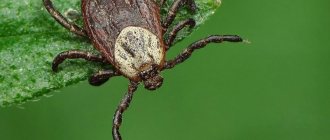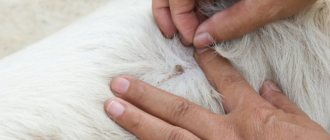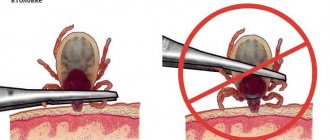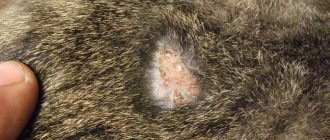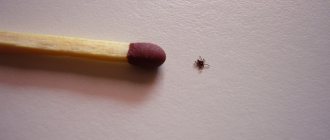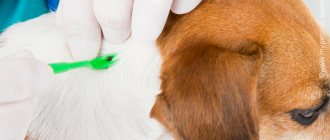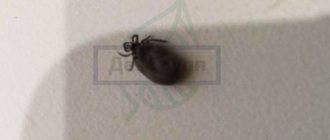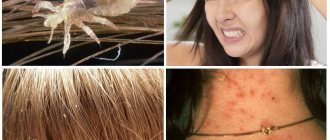What is demodex and demodicosis in dogs, what does the subcutaneous mite and the disease look like?
Demodicosis is a disease that occurs due to a microscopic mite called Demodex canis . The parasite can be found in the epidermis, sebaceous and sweat glands, as well as in hair follicles. By the way, about 200 Demodex individuals can exist simultaneously in one follicle! The thing is that all development cycles of the parasite occur without migration throughout the body.
IMPORTANT: Breeds such as Rottweiler, Great Dane, German Shepherd, Sheltie, Collie, Boxer, Bulldog both French and English, Dachshund, Scotch Terrier, West Highland White Terrier, Cocker Spaniel, Doberman are especially prone to demodicosis. .
If we draw parallels regarding the similarity of Demodex with someone in terms of external characteristics, then we can recall the usual worm that is well known to everyone. Only this “worm” has many legs and jaws.
This is what demodex looks like
Young representatives of ticks feed exclusively on dead cellular material of the dog. But adults eat the outer layer of the skin. This is why the dog’s body becomes covered with terrifying wounds, but we’ll talk about the signs of demodicosis below.
Demodicosis - subcutaneous mite in dogs: types
Despite the fact that the pathogen is the same, the disease can manifest itself in different ways:
- Focal demodicosis - veterinarians classify it as the mildest type . As is easy to understand from the name, only individual foci are affected . There are few of them - from 3 to 5. The risk zone is the head, paws, stomach, and chest. The skin in the affected areas is hairless and tends to peel profusely . Statistics show that 80% of diseases of this type end in cure.
IMPORTANT: However, the owner has no right to relax, since in the absence of treatment or its insufficiency the situation may worsen.
Focal demodicosis on the dog's face
- Generalized - can arise from focal. In this case, large areas are already affected. They acquire a gray or red tint and appears . If the case is neglected, even internal organs may be damaged, which often leads to death. Veterinarians often insist on sterilizing a sick animal , since it may well pass the disease on to its offspring.
Generalized demodicosis in a dog
- Juvenile - it occurs in dogs that are not yet one year old . They inherit the disease from their mother, and due to weak immunity they cannot yet overcome it. The problem can be recognized by formations on the paws and “glasses”.
Juvenile demodicosis in a puppy
Forecast
Focal demodicosis disappears without a trace within 1 to 3 months. Treatment of the generalized form lasts from six months or longer. The indicator of clinical recovery is 2 negative tests of skin scrapings with an interval of 1 month. But a complete cure is stated when there are no relapses throughout the year.
With a generalized form in juvenile age, the risk of the disease returning in the future increases, since this often happens due to genetically determined immunity disorders. Such animals require increased attention and painstaking care.
Demodectic mange in dogs: causes
The most interesting thing is that every dog ! And in many cases it never manifests itself, the animal remains healthy. But why do less fortunate relatives get sick? Scientists still continue to guess, but, nevertheless, they have identified a certain list of factors:
- First of all, demodicosis is provoked by a weakened immune system . It provides all the conditions for Demodex to change its opportunistic status to pathogenic.
IMPORTANT: But do not worry about any pet sneezing, fearing that the tick will also become active with a cold. We are talking about a very strong and sharp decrease in immunity.
- Heredity - this was mentioned above. A weak organism that begins to grow is simply not able to provide a worthy rebuff to the causative agent of the disease. It is quite natural that the disease begins to progress.
- Hair loss can occur due to decreased skin tone . Transferring a dog from its familiar environment to an unusual one is sometimes accompanied by a loss of protective properties of the skin. Mites react quickly to such weakening.
If an animal lived at home for a long time and then began to live outside, it may develop scabies due to demodex.
- If an animal is not eating well , it may have problems. It’s not for nothing that dog breeders and veterinarians unanimously say that the diet should be balanced. This is especially necessary for dogs leading an active lifestyle. Since under heavy load the body especially needs nutrients to produce energy. And small loads and abundant nutrition provoke a concentration of nutrients in the fiber under the skin.
IMPORTANT: The last case is also important to control, since with an increase in the amount of fiber, the skin ceases to be controlled by the immune system and is no longer cleansed normally. This is where the tick becomes active.
- Oncological diseases are also a provoking factor for demodicosis. Some medications have side effects. Most often we are talking about hormonal drugs.
- Hormonal imbalances negatively affect many things, including the development of demodicosis.
Immunity restoration
For any form of demodicosis, create the most favorable conditions for strengthening the dog’s immunity:
- The pet is examined and concomitant diseases are treated if they are detected.
- At home, the conditions of detention are analyzed. Demodex mites love warm, moist environments. The dog's place is located away from radiators. On the street they do not put you in a damp booth or enclosure. The bedding is kept clean, often washed in hot water or changed.
- Carefully protects from stress. Loud noises, unfamiliar people and new animals in the house, and harsh treatment become sources of nervous tension. Some dogs do not tolerate loneliness or travel well, and take a long time to get used to changes.
- Reviewing the diet. When eating natural food, do not overfeed with carbohydrates - cereals, pasta, bread. They do not give sweets, pastries, sausage, bones, or food from the common table. Avoid dry food with low protein content. Do not mix homemade products and industrial feed.
- To restore the skin and coat, it is useful to take a course of injections of the Catozal stimulating solution, add feed sulfur to food at the rate of 0.04 g per 1 kg of weight per day, but not more than 1 g per dog.
In the focal form, these measures are sometimes enough to restore the immune status and stop the spread of demodex. In difficult cases, Immunoparasitan, Fosprenil, Maxidin are included in complex treatment.
There is no consensus in the veterinary community regarding immunomodulators. Many do not see any benefit from them, since the effect of immunostimulants on the immune system that inhibits demodicosis has not been proven.
Demodicosis in dogs: initial signs, symptoms
So, what are the initial symptoms of decomodecosis ?
- Itching , and severe. Of course, all animals itch from time to time. However, if this happens for several hours on end , it is definitely worth taking your dog to the vet.
If your dog itches frequently and for a long time, this may be the initial stage of demodicosis.
- It is worth taking a closer look at the base of the hairs - there will be redness there.
- blisters begin to appear at the sites of such redness . content inside them that can be seen. Its color initially resembles brick, and later clay. This is how the so-called pustular form of the disease manifests itself.
- In some cases, dry scales may be found. Despite the fact that they are dry, the wool next to them seems to stick together. May resemble bran or fish scales.
IMPORTANT: They can sometimes be confused with dirt that has been bleached by the sun, but it is definitely worth taking a closer look at the dog.
- A few days after the scales form, they disappear. You can see pus .
- In some cases, body temperature is approximately 37 degrees. By the way, this is not normal for dogs, since the optimal body temperature for a healthy dog is from 37.5 to 39.4 degrees, depending on its size.
- The dog may refuse to eat and feel depressed.
A dog with demodicosis often has no appetite
Testing for demodicosis in dogs, scraping: where to conduct?
If the above signs appear, the dog must be urgently taken to a specialist in a good, trusted veterinary clinic . Before any treatment is carried out, it is necessary to identify the causative agent. After all, even if the symptoms of a pet’s illness coincide with the signs of demodicosis, the cause of the disease may lie in something else.
The specialist must prescribe bacterial culture. This analysis will allow us to determine with a high degree of accuracy the type of microbe and, as a result, its response to antibiotics.
It is also important to take into account the current condition of the animal, because it is possible that it may have diseases. a specialist can do this , so home treatment based on the advice of friends is excluded.
IMPORTANT: Laboratory tests must be taken not only during diagnosis, but also during treatment every week or two. This will determine whether the animal’s treatment is progressing well.
In order to get rid of demodicosis, the dog must be tested for laboratory testing.
Forms of manifestation
The first signs of Demodex damage appear only after the start of mass reproduction of the subcutaneous mite. Based on the type of symptoms, there are several forms of manifestation of the pathology:
- Generalized demodicosis. It is characterized by extensive skin damage, as seen in the photo. Almost all parts of the pet’s body are involved in the pathological process.
- Focal (simple) form. Here the pathology manifests itself in certain areas of the animal’s body. Most often, signs are noticeable on the head and limbs, where areas of baldness are noted.
- Asymptomatic form. It occurs without visible symptoms on the skin. Demodex mites in dogs are detected only after a thorough examination of the animal.
Treatment of demodicosis in dogs with folk remedies: recipes
Of course, folk remedies cannot be considered as an alternative to visiting a veterinarian and receiving instructions from him. But they will come in handy as additional measures to combat demodicosis. So, what can I recommend:
- A decoction of honey and wormwood has long established itself as a parasite killer. You only need to take a large spoon and fill it with 250 ml of water. The future medicine should boil at least 15 minutes , after which it should sit for some time. Don't forget about straining! After which you can add a teaspoon of honey and give your pet a decoction every couple of hours .
Wormwood is a good helper in the fight against demodicosis
- If your dog loves to bathe, special baths will be a great solution! For example, you can arrange water procedures in oat decoction once a week
IMPORTANT: If you come across a shampoo with this component, you can safely purchase it.
- You can make an excellent ointment from the roots of celandine , for which you only need to stock up on 3-5 roots and 500 ml of oil . The latter must certainly be refined and lean . The sequence of actions is as follows: chop the roots, pour in oil, simmer in the oven at a temperature of up to 50 degrees, strain.
Celandine root has proven itself well in the fight against demodicosis
Does kerosene treat demodicosis in dogs?
There is an opinion that kerosene is excellent in the fight against demodicosis. Proponents of this traditional treatment method prove that if you treat problem areas for 3 days , a film will form on them . This film is impenetrable to the parasite and, therefore, it will have absolutely nothing to breathe. As a result, the tick will begin to climb to the surface on its own.
There is logic in such a recommendation. However, the fact is that not every skin is able to positively perceive such treatment . It is possible that instead of a positive effect, the dog’s skin will become irritated.
IMPORTANT: It is preferable to choose some other less radical method from folk remedies.
Diagnostics
Treatment is not carried out without diagnosis. To do this, the animal is examined and a deep scraping from the affected area of the skin or the contents of the abscess are taken for analysis. Sometimes trichoscopy (hair examination) is performed. Shar-Peis and some other breeds undergo biopsies for histological examination. Subsequently, a scraping is taken to monitor the progress of treatment until recovery.
If demodicosis is diagnosed in an adult dog, a full examination is carried out to identify other health problems that could provoke the proliferation of mites. Then complex treatment is prescribed.
To establish the correct treatment regimen, diseases with similar symptoms are differentiated. These include: eczema, sarcoptic mange, fungal infections, furunculosis, endocrine alopecia, etc.
The most effective treatment regimen for demodicosis in dogs: description
There is no single universal scheme for combating demodicosis with a guaranteed result. But you can try some scheme that definitely won’t do any harm. For example, the following :
- At the first signs, the skin should be treated with fish oil . The litter should be changed as often as possible.
Fish oil is an assistant in the fight against demodicosis
- Of course, it is necessary to get tested , because the medicine is selected depending on the stage of the disease and the breed of the animal. While the results are expected, you should give your pet a bath day, bathing him with antibacterial shampoo.
- After shampoo, it is preferable to treat the skin with an antiseptic lotion .
IMPORTANT: Diet plays a huge role. It should be rich in vitamins A and E.
Contagiousness to animals and people
Demodex causes disease in both animals and humans. The only difference is the type of pathogen. Dog ticks are completely safe for humans, and human ticks are completely safe for dogs. Treatment of a sick pet can be carried out without special protective equipment.
If there are other four-legged animals in the house, be sure to isolate them from the infected person. Transmission of ticks is possible by touching parts of the body: paws, muzzles or ears. During treatment, it is recommended to regularly carry out wet cleaning with disinfectants and treat the sick dog’s personal belongings with acaricidal preparations.
Is demodicosis in dogs contagious to humans?
should definitely not be afraid of infection from a dog Even if the type of tick considered in this case moves onto a person, it will not be able to live there for long - a maximum of a day.
Theoretically, you will only get sick if your immunity is very low. And as low as possible. And this is extremely rare.
A person can safely bathe a dog suffering from demodicosis - it will not become infected
Read also
Ear mites in dogs: Symptoms and treatment of otodectosis
Otodectosis or ear scabies is a chronic invasive disease caused by microscopic itch mites.
Dog castration: 5 reasons for and against
Castration is one of the most responsible ways to care for a dog. With the help of the procedure you will reduce aggression and anxiety associated with testosterone
Ticks in dogs: prevention and treatment
Spring, veterinarians warn, is the beginning of the season for the incidence of piroplasmosis, a deadly disease for dogs.
What diseases are most common in dogs? Symptoms and signs
A dog cannot complain; it is necessary to determine that it is sick by the appearance and behavior of the pet
Fleas on a dog. How to withdraw?
Fleas can cause a lot of discomfort and suffering to your animals, but they must be removed very carefully
Dog demodicosis: photos before and after treatment
If you contact a specialist in a timely manner and follow the recommendations, the dog may well be cured. And here is the evidence for this:
This is how a dog is transformed beyond recognition after treatment for demodicosis
Even a dog seriously ill with demodicosis can be cured with qualified help.
Prevention of demodicosis in dogs: description of a set of measures
How can you avoid such a disease?
- Hygiene comes first! This means, for example, that the litter needs to be changed to clean litter as often as possible.
IMPORTANT: When bathing, do not neglect the use of specialized shampoos.
- As mentioned above, one of the provoking factors for the appearance of demodicosis is a poorly balanced diet. The diet must be saturated with all the necessary substances to maintain normal pet immunity.
- When shedding, it is worth adding sulfur to the diet.
- Contact with sick individuals must be limited , since the possibility of infection still exists.
- Vaccinations - do not succumb to prejudice and believe that a vaccine jeopardizes your health.
- Veterinary preventive examination cannot be neglected! And it should happen at least every 3 months .
To prevent the appearance of demodicosis, the dog must undergo a veterinary examination.
A dog’s skin is much more delicate and sensitive than a human’s - any veterinarian will confirm this. And one can only imagine how much discomfort parasites bring to your beloved pets! It is only in the hands of the owner to protect the dog from such trouble.
